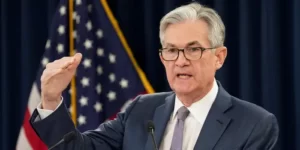The U.S. hasn’t avoided a recession (yet). However, these indicators suggest a gentle landing.
For nearly two years, analysts have held out hope that the Federal Reserve’s assertive interest rate hikes would sufficiently moderate the economy, curbing inflation without triggering a recession.
This week, the once elusive achievement known as a soft landing seemed to transition from a possibility to a probable scenario. While the risks of a recession remain historically significant, this marks a shift from the previous year when a soft landing appeared to be no more than wishful thinking
Outlined below are the positive developments emphasized by some economists.
Will the Fed lower rates in 2024?
To begin, Federal Reserve Chair Jerome Powell unexpectedly remarked on Wednesday that the central bank is likely finished with raising interest rates, given the more rapid decline in inflation. Powell and his colleagues anticipate three rate cuts next year, surpassing previous expectations. This implies that the Fed is shifting its focus from solely combating inflation to dedicating substantial efforts to bolstering economic growth.
In simpler terms, an economy that the Fed was previously calming with Ambien is now poised to receive multiple B-12 shots.
The announcement contributed to an already robust market rally over the past six weeks, with the S&P 500 index gaining an additional 1.6% since the Fed’s statement. The ongoing rally, should it persist, serves as an additional factor contributing to the diminishing likelihood of a recession.
Simultaneously, recent data indicates that inflation is decreasing at a faster rate than economists had anticipated.
Moreover, a separate report emphasizes that consumer spending, constituting 70% of economic activity, remains resilient despite persistently high inflation and interest rates.

What is the current probability of a recession?
Barclays, which had been anticipating a mild recession next year, is no longer expressing concern about the threat, citing the ongoing robust performance of the economy, a decrease in inflation, and the Federal Reserve’s readiness to lower rates. Jonathan Millar, the senior economist at the research firm, states, “At this point, there’s no reason to write down a recession” in the forecast.
Following the Fed’s announcement, Gregory Daco, chief economist of EY-Parthenon, adjusted his recession odds from 50% to approximately 40%.
While achieving a soft landing is not guaranteed, the Fed will need to continue carefully navigating to attain it. Despite expectations of a significant economic slowdown in the coming year, some analysts still predict a mild recession.
The Fed anticipates the economy to grow at a modest rate of 1.4% in 2024, a decline from 2.6% this year.
“We’re not completely out of the woods,” says Kathy Bostjancic, chief economist of Nationwide.
Nevertheless, the likelihood that the U.S. can sidestep a downturn increased this week.
The Fed’s Change in Direction
After implementing a series of interest rate hikes, elevating its key interest from near zero to a range of 5.25% to 5.5% since early last year – marking the most aggressive campaign in 40 years – the Fed now indicates its intention to lower the rate by three-quarters of a point next year. However, this is contingent on the evolving trajectory of the economy and inflation.
Raising rates escalates the costs associated with mortgages, auto loans, credit card purchases, and other forms of borrowing, leading to a reduction in consumer and business demand, ultimately cooling the economy to counteract inflation.
Conversely, cutting rates has the opposite effect, making borrowing more affordable and stimulating growth. It also boosts the stock market by enhancing the relative attractiveness of stocks compared to bonds. As a result, the value of Americans’ 401(k) balances and other investments increases. Over time, individuals tend to feel wealthier and spend more, contributing to economic growth.
Typically, the Fed lowers interest rates to revitalize the economy during a recession. However, next year’s rate cuts are primarily aimed at bringing rates closer to normal now that inflation is nearing its 2% target, according to Kathy Bostjancic. This move is essential to prevent a rise in inflation-adjusted rates.
Simultaneously, the central bank is considering rate cuts as a proactive measure to avert a potential recession as the economy decelerates, adds Bostjancic.
Slowing Inflation Trends
A recent report indicated that wholesale costs remained stagnant in November. This data directly influences the Fed’s favored gauge of consumer prices, the personal consumption expenditure (PCE) index. Barclays predicts that an upcoming report will show a dip in PCE prices in November, while a core measure remains unchanged.
The ongoing moderation in inflation can be attributed primarily to a decline in the prices of furniture, appliances, and other goods that experienced heightened demand during the pandemic, as supply-chain issues have gradually been resolved. Meanwhile, the costs of services such as car repairs, healthcare, and auto insurance have surged, partly due to increased wages linked to labor shortages stemming from the pandemic.
The Fed has been particularly focused on curbing the rise in service prices by increasing rates to cool off the job market and slow down wage hikes.
The November PCE inflation data is expected to reveal a more pronounced slowdown in these cost increases, according to Jonathan Millar. While interest rates may be exerting some influence, the return of many workers sidelined by COVID to the labor market and a rebound in immigration have alleviated worker shortages, contributing to a moderation in wage growth.
Barclays estimates that overall inflation likely decreased to 2.7% from 3% in October, following a 40-year high of 7% last year.
Resilience in Consumer Spending
Consumer spending has displayed unexpected resilience, despite elevated inflation and interest rates, attributed to robust wage hikes that have recently outpaced inflation rates.
Although retail sales experienced a notable deceleration in October, sparking concerns of waning household spending, last month’s data revealed a stronger-than-anticipated increase in retail sales. This underscores robust holiday store traffic, as outlined in a recent report.
Economist Andrew Hunter of Capital Economics emphasized in a note to clients that the sustained and rapid decline in inflation is not occurring at the expense of significantly weaker economic growth.
The Robust Labor Market
While job growth is experiencing a slowdown, it still stands as a robust force, according to Millar. Monthly gains have averaged around 200,000 in the past three months, a decrease from the earlier part of the year when it reached 300,000 but remains historically strong. Moreover, the unemployment rate stands at 3.7%, slightly above a half-century low.
Despite the resilience of the labor market, some economists argue that a mild recession is still on the horizon for the following reasons:
Potential Challenges Indicating Economic Headwinds
While overall job growth remains robust, there are indicators pointing toward a potential steeper slowdown, according to Bostjancic. For instance, service industries such as retail and restaurants, which respond to consumer demand fluctuations, added only 22,000 jobs last month.
The Delayed Effects of High Interest Rates and Inflation
Despite expectations for lower rates and inflation in the coming year, their current elevated levels may start to have a more pronounced impact on consumers and businesses. As rates and inflation persist at high levels, the effects could become more pronounced in the next year.
Dwindling Effects of COVID Savings
The substantial savings amassed by Americans during the pandemic, totaling over $2 trillion from federal stimulus checks and increased savings during lockdowns, are running low. This reduction in cash reserves removes a buffer against high rates and inflation, especially for low- and moderate-income households.
Corporate Profit Squeeze
Corporate profit margins are already narrowing due to decreased pricing power in the face of lower inflation. Earnings are anticipated to face additional pressure next year as the economy slows down, leading to reduced sales.
Potential Increase in Layoffs
As companies grapple with maintaining profits, they may resort to increased layoffs. Job cuts have been restrained due to pandemic-related labor shortages, but the situation could change as economic conditions evolve.
Balancing Act for the Fed
The Federal Reserve faces the challenge of striking a delicate balance. If the Fed cuts rates too aggressively, it could stimulate the economy to the extent that inflation reemerges, necessitating a reversal of the rate-cutting strategy. This, in turn, could elevate the risk of recession once again, underscoring a real risk in the current economic landscape.
For more news click
-
2023 Best Credit Card to use in USA
-
A criticizer excludes on a $6 million grands by selling his own Apple stocks for about 70000% of its current Value on date.
-
Forbes Hall of Shame List, Crazy Here is the list.
-
Ross Stores surpasses Expectations with Robust earnings in the Third quarter of 2024.

